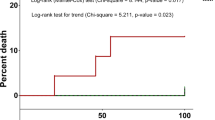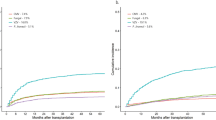Abstract
Infection is one of the main causes of early-treatment mortality in multiple myeloma (MM) patients during autologous stem cell transplantation (autoSCT). In the present study, we sought to determine the incidence of, and risk factors for, infection during hospital stays after autoSCT. We retrospectively evaluated 324 autoSCT events that occurred in 285 MM patients between 2006 and 2015, and reviewed the clinical characteristics of patients and history of infections. Sixty-eight infection events occurred, including bacteremia (24), other bacterial infections (7), as well as infections caused by Cytomegalovirus (17), Herpes simplex virus (12), Varicella zoster virus (3), Aspergillus (3) and Pneumocystis jiroveci (2). There was no significant difference in number of infections in the 2006–2010 and 2011–2015 periods (P = 0.194). Risk factors for bacteremia included higher beta-2 microglobulin levels at diagnosis [≥3.5 mg/L; adjusted odds ratio (aOR) 3.544 (95% CI 1.070–11.736), P = 0.038] and previous bortezomib treatment [aOR 4.270 (95% CI 1.389–13.125), P = 0.011]. In-hospital mortality occurred in 1.2% of all cases and all were infection-related. In conclusion, infection was the main cause of in-hospital mortality in patients who underwent autoSCT. Bacteremia was the most common type of microbiologically confirmed infection, and was associated with higher beta-2 microglobulin levels and previous bortezomib treatment.
Similar content being viewed by others
References
Cherng NC, Asal NR, Kuebler JP, Lee ET, Solanki D. Prognostic factors in multiple myeloma. Cancer. 1991;67(12):3150–6.
Kumar SK, Rajkumar SV, Dispenzieri A, Lacy MQ, Hayman SR, Buadi FK, et al. Improved survival in multiple myeloma and the impact of novel therapies. Blood. 2008;111(5):2516–20.
Augustson BM, Begum G, Dunn JA, Barth NJ, Davies F, Morgan G, et al. Early mortality after diagnosis of multiple myeloma: analysis of patients entered onto the United kingdom Medical Research Council trials between 1980 and 2002—Medical Research Council Adult Leukaemia Working Party. J Clin Oncol. 2005;23(36):9219–26.
Nucci M, Anaissie E. Infections in patients with multiple myeloma in the era of high-dose therapy and novel agents. Clin Infect Dis. 2009;49(8):1211–25.
Gil L, Styczynski J, Komarnicki M. Infectious complication in 314 patients after high-dose therapy and autologous hematopoietic stem cell transplantation: risk factors analysis and outcome. Infection. 2007;35(6):421–7.
Satlin MJ, Vardhana S, Soave R, Shore TB, Mark TM, Jacobs SE, et al. Impact of prophylactic levofloxacin on rates of bloodstream infection and fever in neutropenic patients with multiple myeloma undergoing autologous hematopoietic stem cell transplantation. Biol Blood Marrow Transplant. 2015;21(10):1808–14.
Li J, Huang BH, Zhou ZH, Zheng D, Xu DR, Zou WY. The clinical features of infection in multiple myeloma undergoing autologous hematopoietic stem cell transplantation. Zhonghua Nei Ke Za Zhi. 2011;50(1):44–7.
Jones JA, Qazilbash MH, Shih YC, Cantor SB, Cooksley CD, Elting LS. In-hospital complications of autologous hematopoietic stem cell transplantation for lymphoid malignancies: clinical and economic outcomes from the Nationwide Inpatient Sample. Cancer. 2008;112(5):1096–105.
Srinivasan A, McLaughlin L, Wang C, Srivastava DK, Shook DR, Leung W, et al. Early infections after autologous hematopoietic stem cell transplantation in children and adolescents: the S. Jude experience. Transpl Infect Dis. 2014;16(1):90–7.
Reich G, Mapara MY, Reichardt P, Dorken B, Maschmeyer G. Infectious complications after high-dose chemotherapy and autologous stem cell transplantation: comparison between patients with lymphoma or multiple myeloma and patients with solid tumors. Bone Marrow Transplant. 2001;27(5):525–9.
Munshi HG, Montgomery RB. Evidence-based case review: severe neutropenia: a diagnostic approach. West J Med. 2000;172(4):248.
Freifeld AG, Bow EJ, Sepkowitz KA, Boeckh MJ, Ito JI, Mullen CA, et al. Clinical practice guideline for the use of antimicrobial agents in neutropenic patients with cancer: 2010 update by the Infectious Diseases Society of America. Clin Infect Dis. 2011;52(4):e56–93.
Weinstein MP. Blood culture contamination: persisting problems and partial progress. J Clin Microbiol. 2003;41(6):2275–8.
De Pauw B, Walsh TJ, Donnelly JP, Stevens DA, Edwards JE, Calandra T, et al. Revised definitions of invasive fungal disease from the European Organization for Research and Treatment of Cancer/Invasive Fungal Infections Cooperative Group and the National Institute of Allergy and Infectious Diseases Mycoses Study Group (EORTC/MSG) Consensus Group. Clin Infect Dis. 2008;46(12):1813–21.
Greipp PR, San Miguel J, Durie BG, Crowley JJ, Barlogie B, Blade J, et al. International staging system for multiple myeloma. J Clin Oncol. 2005;23(15):3412–20.
Durie BG, Harousseau JL, Miguel JS, Blade J, Barlogie B, Anderson K, et al. International uniform response criteria for multiple myeloma. Leukemia. 2006;20(9):1467–73.
Pratt G, Goodyear O, Moss P. Immunodeficiency and immunotherapy in multiple myeloma. Br J Haematol. 2007;138(5):563–79.
Cesana C, Nosari AM, Klersy C, Miqueleiz S, Rossi V, Ferrando P, et al. Risk factors for the development of bacterial infections in multiple myeloma treated with two different vincristine-adriamycin-dexamethasone schedules. Haematologica. 2003;88(9):1022–8.
Blimark C, Holmberg E, Mellqvist UH, Landgren O, Bjorkholm M, Hultcrantz M, et al. Multiple myeloma and infections: a population-based study on 9253 multiple myeloma patients. Haematologica. 2015;100(1):107–13.
Jagannath S, Barlogie B, Berenson J, Siegel D, Irwin D, Richardson PG, et al. A phase 2 study of two doses of bortezomib in relapsed or refractory myeloma. Br J Haematol. 2004;127(2):165–72.
Nooka AK, Kaufman JL, Behera M, Langston A, Waller EK, Flowers CR, et al. Bortezomib-containing induction regimens in transplant-eligible myeloma patients: a meta-analysis of phase 3 randomized clinical trials. Cancer. 2013;119(23):4119–28.
Mya DH, Han ST, Linn YC, Hwang WY, Goh YT, Tan DC. Risk of hepatitis B reactivation and the role of novel agents and stem-cell transplantation in multiple myeloma patients with hepatitis B virus (HBV) infection. Ann Oncol. 2012;23(2):421–6.
Basler M, Lauer C, Beck U, Groettrup M. The proteasome inhibitor bortezomib enhances the susceptibility to viral infection. J Immunol. 2009;183(10):6145–50.
Li J, Li Y, Huang B, Zheng D, Chen M, Zhou Z. Drug-induced modulation of T lymphocytes as a potential mechanism of susceptibility to infections in patients with multiple myeloma during bortezomib therapy. Cell Biochem Biophys. 2015;71(1):457–64.
Chanan-Khan A, Sonneveld P, Schuster MW, Stadtmauer EA, Facon T, Harousseau JL, et al. Analysis of herpes zoster events among bortezomib-treated patients in the phase III APEX study. J Clin Oncol. 2008;26(29):4784–90.
Hyun SY, Han SH, Kim SJ, Jang JE, Kim Y, Cho H, et al. Pretreatment lymphopenia, poor performance status, and early courses of therapy are risk factors for severe bacterial infection in patients with multiple myeloma during treatment with bortezomib-based regimens. J Korean Med Sci. 2016;31(4):510–8.
Bradley LM, Dalton DK, Croft M. A direct role for IFN-gamma in regulation of Th1 cell development. J Immunol. 1996;157(4):1350–8.
Blanco B, Perez-Simon JA, Sanchez-Abarca LI, Carvajal-Vergara X, Mateos J, Vidriales B, et al. Bortezomib induces selective depletion of alloreactive T lymphocytes and decreases the production of Th1 cytokines. Blood. 2006;107(9):3575–83.
Spellberg B, Edwards JE Jr. Type 1/Type 2 immunity in infectious diseases. Clin Infect Dis. 2001;32(1):76–102.
Kara EE, Comerford I, Fenix KA, Bastow CR, Gregor CE, McKenzie DR, et al. Tailored immune responses: novel effector helper T cell subsets in protective immunity. PLoS Pathog. 2014;10(2):e1003905.
Peck A, Mellins ED. Precarious balance: Th17 cells in host defense. Infect Immun. 2010;78(1):32–8.
Andreasen C, Powell DA, Carbonetti NH. Pertussis toxin stimulates IL-17 production in response to Bordetella pertussis infection in mice. PLoS One. 2009;4(9):e7079.
Griffin GK, Newton G, Tarrio ML, Bu DX, Maganto-Garcia E, Azcutia V, et al. IL-17 and TNF-alpha sustain neutrophil recruitment during inflammation through synergistic effects on endothelial activation. J Immunol. 2012;188(12):6287–99.
Kim JW, Min CK, Mun YC, Park Y, Kim BS, Nam SH, et al. Varicella-zoster virus-specific cell-mediated immunity and herpes zoster development in multiple myeloma patients receiving bortezomib- or thalidomide-based chemotherapy. J Clin Virol. 2015;73:64–9.
Beysel S, Yegin ZA, Yagci M. Bortezomib-associated late hepatitis B reactivation in a case of multiple myeloma. Turk J Gastroenterol. 2010;21(2):197–8.
Pilarski LM, Mant MJ, Ruether BA. Analysis of immunodeficiency in multiple myeloma: observations and hypothesis. J Clin Lab Anal. 1987;1(2):214–28.
Isoda A, Matsumoto M, Nakahashi H, Mawatari M, Manaka A, Sawamura M. Reduced risk of bacterial infection in multiple myeloma patients with VAD regimen without intermittent high-dose dexamethasone. Int J Hematol. 2011;93(1):59–65.
Corso A, Castelli G, Pagnucco G, Lazzarino M, Bellio L, Klersy C, et al. Bone marrow T-cell subsets in patients with monoclonal gammopathies: correlation with clinical stage and disease status. Haematologica. 1997;82(1):43–6.
Bataille R, Grenier J, Sany J. Beta-2-microglobulin in myeloma: optimal use for staging, prognosis, and treatment–a prospective study of 160 patients. Blood. 1984;63(2):468–76.
Weaver CH, Schwartzberg LS, Hainsworth J, Greco FA, Li W, Buckner CD, et al. Treatment-related mortality in 1000 consecutive patients receiving high-dose chemotherapy and peripheral blood progenitor cell transplantation in community cancer centers. Bone Marrow Transplant. 1997;19(7):671–8.
Valkovic T, Gacic V, Ivandic J, Petrov B, Dobrila-Dintinjana R, Dadic-Hero E, et al. Infections in hospitalised patients with multiple myeloma: main characteristics and risk factors. Turk J Haematol. 2015;32(3):234–42.
Tess BH, Glenister HM, Rodrigues LC, Wagner MB. Incidence of hospital-acquired infection and length of hospital stay. Eur J Clin Microbiol Infect Dis. 1993;12(2):81–6.
Verbosky LA, Franco KN, Zrull JP. The relationship between depression and length of stay in the general hospital patient. J Clin Psychiatry. 1993;54(5):177–81.
Acknowledgements
The authors thank all of the patients who participated in this study.
Author information
Authors and Affiliations
Corresponding authors
Ethics declarations
Conflict of interest
The authors declare that they have no competing interest.
About this article
Cite this article
Park, H., Youk, J., Kim, H.R. et al. Infectious complications in multiple myeloma receiving autologous stem cell transplantation in the past 10 years. Int J Hematol 106, 801–810 (2017). https://doi.org/10.1007/s12185-017-2313-2
Received:
Revised:
Accepted:
Published:
Issue Date:
DOI: https://doi.org/10.1007/s12185-017-2313-2




